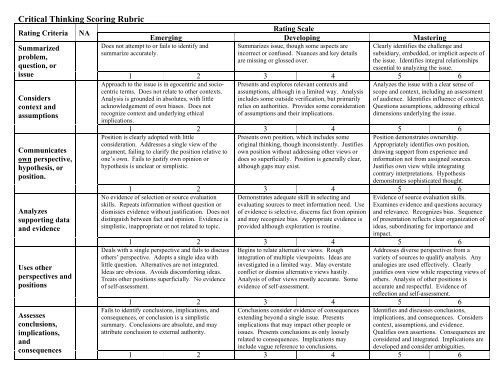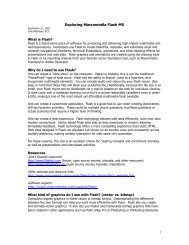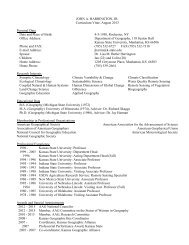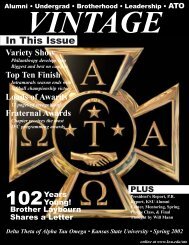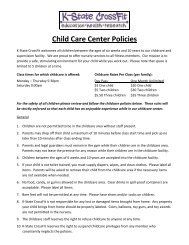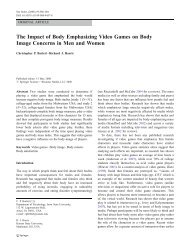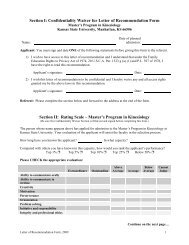Critical Thinking Scoring Rubric - Kansas State University
Critical Thinking Scoring Rubric - Kansas State University
Critical Thinking Scoring Rubric - Kansas State University
Create successful ePaper yourself
Turn your PDF publications into a flip-book with our unique Google optimized e-Paper software.
<strong>Critical</strong> <strong>Thinking</strong> <strong>Scoring</strong> <strong>Rubric</strong><br />
Rating Criteria<br />
NA<br />
Rating Scale<br />
Emerging Developing Mastering<br />
Summarizes issue, though some aspects are<br />
incorrect or confused. Nuances and key details<br />
are missing or glossed over.<br />
Summarized<br />
Does not attempt to or fails to identify and<br />
summarize accurately.<br />
problem,<br />
question, or<br />
issue 1 2 3 4 5 6<br />
Considers<br />
context and<br />
assumptions<br />
Communicates<br />
own perspective,<br />
hypothesis, or<br />
position.<br />
Analyzes<br />
supporting data<br />
and evidence<br />
Uses other<br />
perspectives and<br />
positions<br />
Assesses<br />
conclusions,<br />
implications,<br />
and<br />
consequences<br />
Approach to the issue is in egocentric and sociocentric<br />
terms. Does not relate to other contexts.<br />
Analysis is grounded in absolutes, with little<br />
acknowledgement of own biases. Does not<br />
recognize context and underlying ethical<br />
implications.<br />
Position is clearly adopted with little<br />
consideration. Addresses a single view of the<br />
argument, failing to clarify the position relative to<br />
one’s own. Fails to justify own opinion or<br />
hypothesis is unclear or simplistic.<br />
Presents and explores relevant contexts and<br />
assumptions, although in a limited way. Analysis<br />
includes some outside verification, but primarily<br />
relies on authorities. Provides some consideration<br />
of assumptions and their implications.<br />
Clearly identifies the challenge and<br />
subsidiary, embedded, or implicit aspects of<br />
the issue. Identifies integral relationships<br />
essential to analyzing the issue.<br />
Analyzes the issue with a clear sense of<br />
scope and context, including an assessment<br />
of audience. Identifies influence of context.<br />
Questions assumptions, addressing ethical<br />
dimensions underlying the issue.<br />
1 2 3 4 5 6<br />
Presents own position, which includes some<br />
original thinking, though inconsistently. Justifies<br />
own position without addressing other views or<br />
does so superficially. Position is generally clear,<br />
although gaps may exist.<br />
Position demonstrates ownership.<br />
Appropriately identifies own position,<br />
drawing support from experience and<br />
information not from assigned sources.<br />
Justifies own view while integrating<br />
contrary interpretations. Hypothesis<br />
demonstrates sophisticated thought.<br />
1 2 3 4 5 6<br />
No evidence of selection or source evaluation<br />
skills. Repeats information without question or<br />
dismisses evidence without justification. Does not<br />
distinguish between fact and opinion. Evidence is<br />
simplistic, inappropriate or not related to topic.<br />
Deals with a single perspective and fails to discuss<br />
others’ perspective. Adopts a single idea with<br />
little question. Alternatives are not integrated.<br />
Ideas are obvious. Avoids discomforting ideas.<br />
Treats other positions superficially. No evidence<br />
of self-assessment.<br />
Demonstrates adequate skill in selecting and<br />
evaluating sources to meet information need. Use<br />
of evidence is selective, discerns fact from opinion<br />
and may recognize bias. Appropriate evidence is<br />
provided although exploration is routine.<br />
Evidence of source evaluation skills.<br />
Examines evidence and questions accuracy<br />
and relevance. Recognizes bias. Sequence<br />
of presentation reflects clear organization of<br />
ideas, subordinating for importance and<br />
impact.<br />
1 2 3 4 5 6<br />
Begins to relate alternative views. Rough<br />
integration of multiple viewpoints. Ideas are<br />
investigated in a limited way. May overstate<br />
conflict or dismiss alternative views hastily.<br />
Analysis of other views mostly accurate. Some<br />
evidence of self-assessment.<br />
Fails to identify conclusions, implications, and<br />
consequences, or conclusion is a simplistic<br />
summary. Conclusions are absolute, and may<br />
attribute conclusion to external authority.<br />
Addresses diverse perspectives from a<br />
variety of sources to qualify analysis. Any<br />
analogies are used effectively. Clearly<br />
justifies own view while respecting views of<br />
others. Analysis of other positions is<br />
accurate and respectful. Evidence of<br />
reflection and self-assessment.<br />
1 2 3 4 5 6<br />
Conclusions consider evidence of consequences Identifies and discusses conclusions,<br />
extending beyond a single issue. Presents implications, and consequences. Considers<br />
implications that may impact other people or context, assumptions, and evidence.<br />
issues. Presents conclusions as only loosely Qualifies own assertions. Consequences are<br />
related to consequences. Implications may considered and integrated. Implications are<br />
include vague reference to conclusions.<br />
developed and consider ambiguities.<br />
1 2 3 4 5 6
Communicates<br />
effectively<br />
In many places, language obscures meaning.<br />
Grammar, syntax, or other errors are distracting or<br />
repeated. Little evidence of proofreading. Style is<br />
inconsistent or inappropriate.<br />
Work is unfocused and poorly organized; lacks<br />
logical connection of ideas. Format is absent,<br />
inconsistent or distracting.<br />
Few sources are cited or used correctly.<br />
In general, language does not interfere with<br />
communication.<br />
Errors are not distracting or frequent, although<br />
there may be some problems with more difficult<br />
aspects of style and voice.<br />
Basic organization is apparent; transitions connect<br />
ideas, although they may be mechanical. Format<br />
is appropriate although at times inconsistent.<br />
Most sources are cited and used correctly.<br />
Language clearly and effectively<br />
communicates ideas. May at times be<br />
nuanced and eloquent.<br />
Errors are minimal. Style is appropriate for<br />
audience.<br />
Organization is clear; transitions between<br />
ideas enhance presentation. Consistent use<br />
of appropriate format. Few problems with<br />
other components of presentation.<br />
All sources are cited and used correctly,<br />
demonstrating understanding or economic,<br />
legal, and social issues involved with the use<br />
of the information.<br />
1 2 3 4 5 6<br />
©2006 – Center for Teaching, Learning, & Technology at Washington <strong>State</strong> <strong>University</strong>


